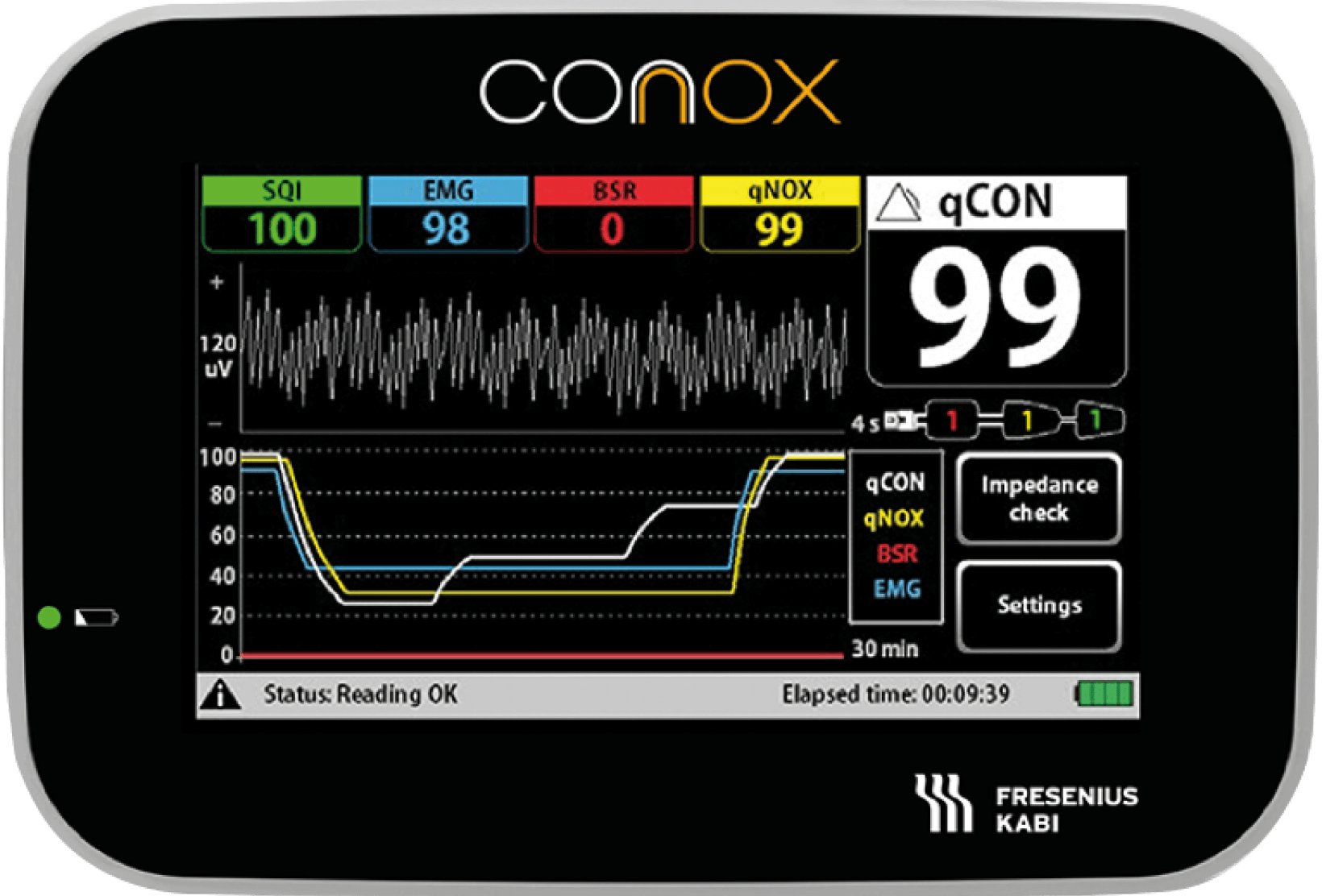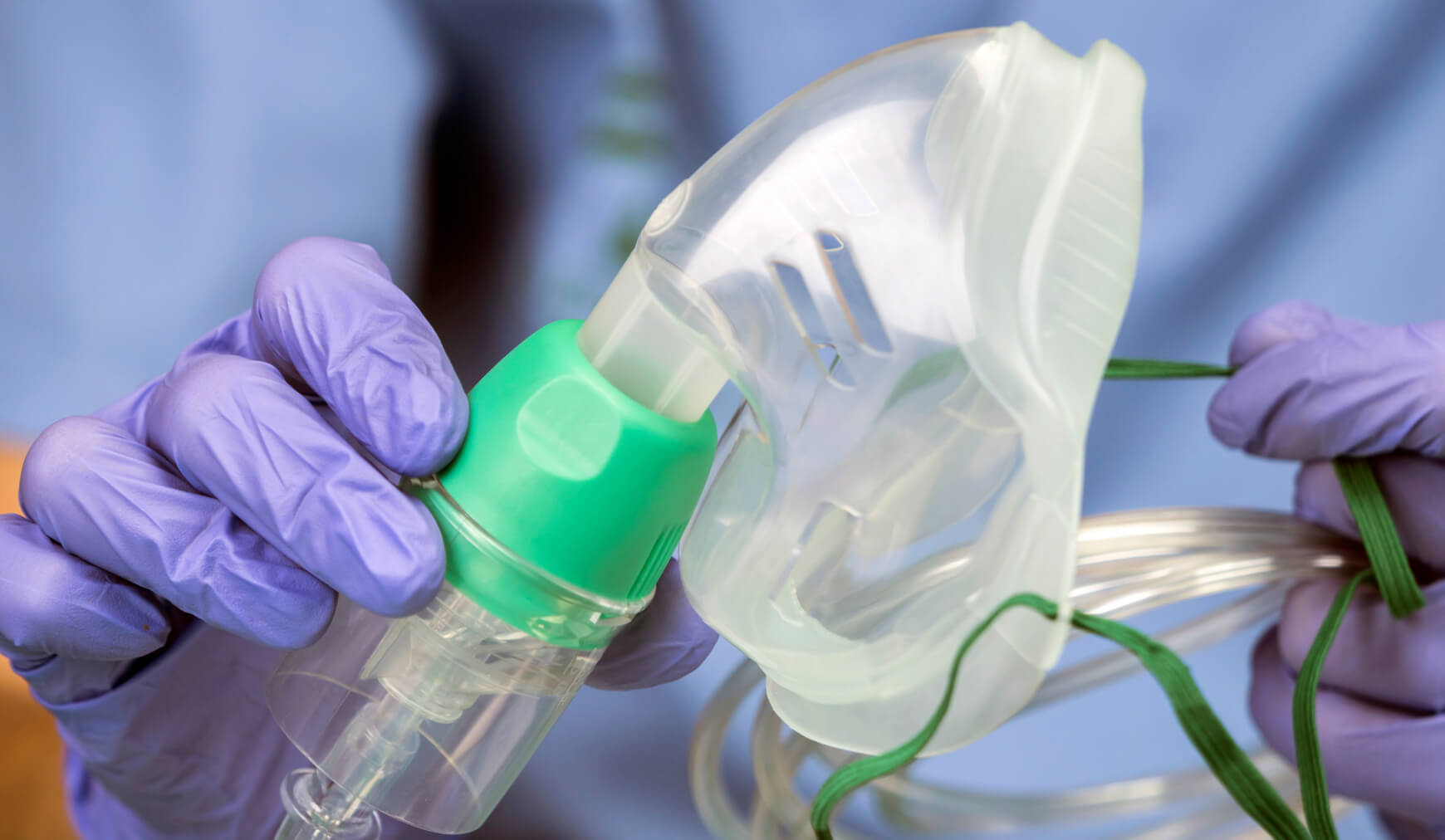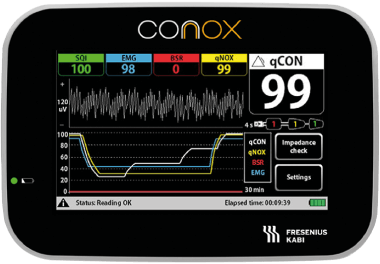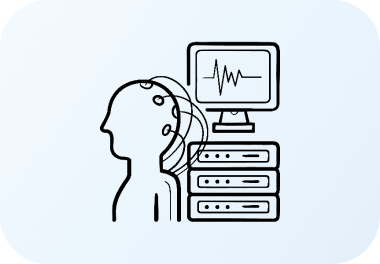
Интеллектуальный
Мониторинг Анестезии

Что такое Conox®?
Conox® – неинвазивный монитор глубины анестезии и анальгезии.
Он позволяет оценить как гипнотический, так и анальгетический эффект при проведении седации или общей анестезии
Два мониторируемых параметра в одном устройстве

qNOX и qCON
Мониторинг глубины анестезии4,5 способствует:
Более точному дозированию анестетиков
Более точному прогнозированию проводимой анестезии
(например, динамика индекса qNOX может указать момент для проведения интубации трахеи).
Снижению вероятности пробуждения во время операции
Снижению частоты послеоперационных осложнений, в том числе послеоперационную тошноту и рвоту
Снижению длительности пребывания в стационаре после операции
Сравнение с аналогом
 Conox
Conox
 Монитор глубины анестезии на основе биспектрального индекса
Монитор глубины анестезии на основе биспектрального индекса
Литература
1. E.W. Jensen, P.L. Gambús, P. Pineda, J.F. Valencia, M. Jospin, M.M.R.F. Struys and H.E.M. Vereecke, “Prediction of response to tetanic stimulation: what is best, an interaction model or a direct brain measurement?”, European Journal of Anaesthesiology, vol. 31, e-Sup. 52, p.32, Abstract Ap2-1, Jun 2014.
2. E.W. Jensen, J.F. Valencia, A. López, T. Anglada, M. Agustí, Y. Ramos, R. Serra, M. Jospin, P. Pineda and P. Gambús, “Monitoring hypnotic effect and nociception with two EEG-derived indices, qCON and qNOX, during general anaesthesia”, Acta Anaesthesiologica Scandinavica, vol. 58(8), pp. 933-941, Sep 2014.
3. U. Melia, E. Gabarrón, M. Agustí, N. Souto, P. Pineda, J. Fontanet, M. Vallverdú, E.W. Jensen and P. Gambús, “Comparison of the qCON and qNOX indices for the assessment of unconsciousness level and noxious stimulation response during surgery”, Journal of Clinical Monitoring and Computing, vol. 30, no. 6, pp. 1273-1281, Oct 2016.
4. Punjasawadwong Y, Chau-In W, Laopaiboon M, Punjasawadwong S, Pin-On P. Processed electroencephalogram and evoked potential techniques for amelioration of postoperative delirium and cognitive dysfunction following non-cardiac and non-neurosurgical procedures in adults. Cochrane Database Syst Rev. 2018 May 15;5(5):CD011283. doi: 10.1002/14651858.CD011283.pub2. PMID: 29761891; PMCID: PMC6494561.
5. Ling L, Yang TX, Lee SWK. Effect of Anaesthesia Depth on Postoperative Delirium and Postoperative Cognitive Dysfunction in High-Risk Patients: A Systematic Review and Meta-Analysis. Cureus. 2022 Oct 10;14(10):e30120. doi: 10.7759/cureus.30120. PMID: 36381936; PMCID: PMC9643022.
6. J.F. Valencia, X. Borrat and P.L. Gambús, “Validation of a new index, qCON, for assessment of the level of consciousness during sedation”, presented at the ASA Annual meeting, Abstract A640, Oct 2012.
7. J.F. Valencia, X. Borrat, M. Struys and H. Vereecke, “Assessment of the level of consciousness during propofol anaesthesia: validation of the qCON index”, European Journal of Anaesthesiology, vol. 30, e-Sup. 51, p. 42, Abstract 3AP2-6, Jun 2013.
8. R. Zanner, R., M. Kreuzer, A. Meyer, E. Kochs and G. Schneider, “Evaluation of qCON, a novel monitor of the hypnotic component of anaesthesia”, presented at European Society of Anaesthesiology Congress, Abstract 1AP15-10, 2015.
9. R. Zanner, S. Pilge, E.F. Kochs, M. Kreuzer and G. Chneider, “Time delay of electroencephalogram index calculation: analysis of cerebral state, bispectral and Narcotrend indices using perioperatively recorded electroencephalographic signals”, British Journal of Anaesthesia, vol. 103 (3), pp. 394-399, July 2009.
10. M. Kreuzer, R. Zanner, S. Pilge, S. Paprotny, E.F. Kochs, G. Schneider, “Time delay of monitors of the hypnotic component of anaesthesia: analysis of State Entropy and Index of Consciousness”, Anesthesia and Analgesia, vol. 115 (2), pp. 315-319, August 2012
11. P. Pineda, E.W. Jensen, M. Jospin and P. Gambús, “Comparison of the reliability and stability of two depth of anaesthesia monitors”, Navat (CREB - Fundació Hospital Clínic Barcelona), 2014.